BIOL 208: Lecture 10 - Heterotrophs
1/88
There's no tags or description
Looks like no tags are added yet.
Name | Mastery | Learn | Test | Matching | Spaced |
|---|
No study sessions yet.
89 Terms
What Carbon source do heterotrophs use to get E?
ORGANIC sources of carbon synth by others
What organism groups use heterotrophy?
ALL
Prokaryotes
Protists
Plants (to a lesser degree)
Fungi
Animals
True or False: ALL Fungi + Animals are heterotrophs
TRUE
What are the 3 functional groups of Heterotrophy?
Herbivore
Carnivore
Detritivores
What are functional groups/ how are they categorized?
Groups based on how they use resources + ecological role
What are Detritivores?
Organisms that eat dead organic matter (it used to be alive but is no longer living)
Food economics of Heterotrophs: Heterotrophs need to balance the ____ of obtaining food and its ____
Balance ease of obtaining food + its quality
What is the balancing of ease + quality an example of?
TRADE OFF
Impossible to find food that is both easy to obtain and high in quality
What is Ecological Stoichiometry?
The balance of 5 elements in ecological interactions
*****What 5 elements are balanced in Ecological stoichiometry?
Carbon
O
H
N
Phosphorus
CHONP
*****Where can these 5 elements be found/what functions do they play?
C = provide structure to organisms
O = part of water
H = part of water
N = Part of aa + Nucleic acids
P = Essential for cellular processes eg. ATP
These 5 elements make up _______ of the biomass of plants animals fungi + bacteria
93 - 97%
****Which of the 5 elements is the most LIMITING factor for ALL organisms?
Nitrogen
The ratio of What 2 of the 5 elements dictate what/ how much of each type of food source a heterotroph needs to eat
C:N Ratio
Relative abundance of C + N
What are the 2 groups of Food sources + what are the C:N ratios?
Plants = High C:N ratio (Lots of carbon to build structure)
Animal, Fungi + Bacteria = Low C:N ratio (structural components = less C rich)
Why does fungi have slightly higher C:N ratio than animals or bacteria?
Chitin structures
What are the 3 challenge of being a herbivore?
NUTRITIONAL QUALTITY
Ease = very easy to obtain food
Quality = very low
Plant defenses
Exposure to predators
Why are plants so low in Nutritional quality
High C:N ratio
Why do herbivores make adaptations to their teeth in order to ingest + digest food?
High C:N ratio = plants are HARD TO INGEST + DIGEST (esp. high cellulose + lignin)
*****What are 2 types of plant defenses that make eating plants difficult?
Physical = thorns + spikes
Chemical = alkaloids, cyanide + tannins
What do alkaloids, cyanide + tannins do respectively?
Alkaloids = bitter
Cyanide = Kill you
Tannins = binds other nutrients
******How do herbivores compensate for Low nutritional quality? 2 ways
EAT A LOT
Adaptations to digestive system
What functional group of heterotrophy has the Highest relationship with Symbionts?
Herbivores
Why do herbivores have such a high relationship with symbionts?
Help digest food
eg. Gut microbiome can help digest insoluble fiber
Why is exposure to predators a challenge for herbivores?
Low nutrient quality = have to eat a lot = spending a lot of time in the open, exposed to predators
What are some examples of adaptations that herbivores use to help with exposure to predators?
Porcupine + quills
Bison = size + horns
Carnivory: compare ease vs. quality of food
Ease = low very difficult to obtain food
Quality = extremely high
True or false: a predator can use multiple prey species to get the same nutrition? Why?
True
Little variation in C:N ratio across animal species
Fill in the blank: There is a _____ (strong/weak) selection to efficiently capture + consume prey for carnivores?
STRONG SELECTION
Why is there a strong selection for the ability to catch + eat prey?
Although animals have high quality of nutrition they are HARD TO CATCH
****What are 3 examples of carnivory adaptation?
Fast
Sharp claws
Teeth for tearing + efficiently consuming prey
*****Compare the Ease + Quality of food for DETRITIVORES
Ease = easy
Quality = VARIES
*****Why does quality of food VARY for Detritivores?
Dead plants + dead animals do not have the same quality of nutrients
Rank Dead animals Dead plants + feces in order from LOWEST quality to highest quality of nutrients
LOWEST = Dead plants (High C:N)
Feces
HIGHEST = Dead animals (Low C:N)
True or False: All decomposers are Detritivores but not all detritivores are decomposers
FALSE
All detritivores = decomposers but not all Decomposers = detritivores
Why are all Detritivores decomposers but not all decomposers detritivores?
Detritivores are a sub category of decomposers
detritivores = organisms that PHYSICALLT INGEST + DIGEST through internal processes
Decomposers can also include organisms that break down matter externally
Define Decomposer vs. detritivore
Decomposer: chemically breaks down dead organic matter release enzymes externally and absorb nutrients directly.]
Detritivore: feeds on detritus — dead plants, animals, and organic waste — by ingesting it and digesting it inside their body.
What is the most abundant food source on this planet?
Dead plant material
Although its the most abundant, what is an issue with dead plants as a food source?
Rich in carbon and energy but low in nitrogen
******Why are dead plants so low in nitrogen?
Nitrogen Use Efficiency (NUE) on top of already having a high C:N ratio
What is Nitrogen Use Efficiency (NUE)
Plants REABSORB NITROGEN before dropping leaves = even less nitrogen
Other than NUE what is another potential issue/challenge with dead plant material as food
Fresh detritus(recently fallen leaves) may also still have PLANT CHEMICAL DEFENCES
****Detritivores are not limited by food abundance: What are the 2 things detritivores are limited by?
Chemical composition of detritus (C vs. N)
Abiotic factors: Soil moisture (very prone to DESICATION)
Define Mixotrophs.
Can gain E from Photosynthesis (inorganic) AND from consuming organic material
What are some examples of mixotrophs?
Algae, bacteria, protists, hemi-parasitic plants + carnivorous plants
What are Myco-heterotrophic Plants?
HETEROTROPHIC PLANTS
Obtain food from FUNGAL HYPHAE
Do Myco-heterotrophic plants have Chloroplast? Why or Why not?
NO
Heterotrophs, don’t do photosynthesis
Of the 3 types of plants listed below. Which are mixotrophs and which is not? Why?
Hemi-parasites eg. Mistletoe
Epiphytes eg. orchids
Insectivorous plants eg. Venus fly trap
Epiphytes = AUTOTROPH
plants that grow on other plants but do not use their nutrients or energy
How are hemiparasites Mixotrophs?
Obtain food from living plant host + can perform photosynthesis
How are insectivorous plants Mixotrophs?
Obtain Additional nutrients from trapped insects
in bogs with low nutrient availability
******What is the Functional response (type 1-3) of animals? What does it describe what is x and what is y?
Energy limit in animals (much like plants + photosynthetic rate)
Describes: Food intake per unit time as a function of prey density or amount of food available
*****What are the 5 things that influence an organisms Feeding rate?
Can only fit so much food in mouth at a time
Takes time to digest + make room for more food
Takes time to find food
Takes time to handle + process food
Consider safety while foraging; sometimes it’s safer to hide than eat
****What group of animals does point #5 of influences on feeding rate not apply to?
Apex predators
******Compare the Shapes of the 3 functional response curves.
Type 1 = LINEAR
Type 2 = Curved
Type 3 = S shape
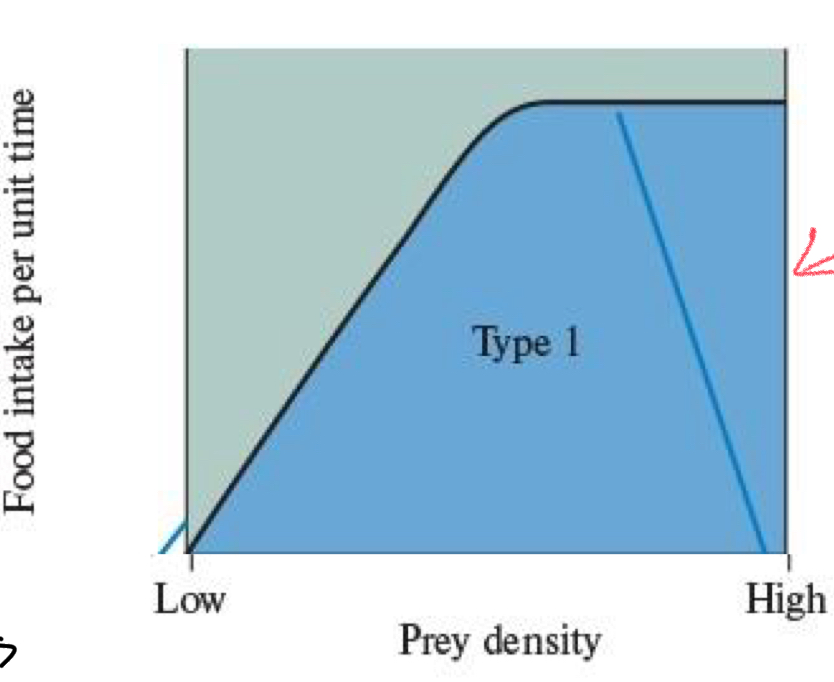
*****Why is the Type 1 Curve linear?
Food is readily available = negligible searching time
RATE OF ENCOUNTER directly DRIVES RATE OF INTAKE'
Quick food processing = NO HANDLING TIME
Intake is purely limited by exposure rate not by processing time.
What is the Cause for the abrupt leveling off of the Type 1 functional response curve?
Satiation (no handling constraints)
Rate of intake doesn’t go any higher because the animal is full
******What are some examples of Animals who may have a Type 1 Functional response curve?
Filter feeders = WHALES
some Zooplankton
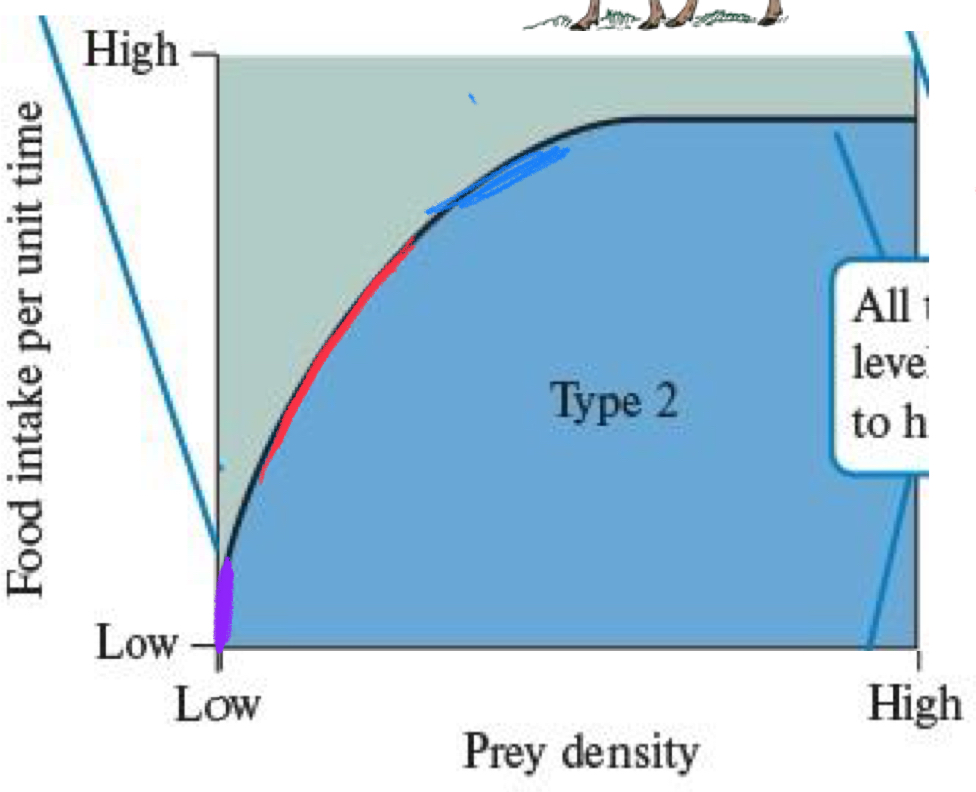
*****Why is the Type 2 Curve Hyperbolic/CURVED?
Feeding is limited by HANDLING TIME
*****At low food density the Type 2 curve rate increases ______ (linearly/hyperbolically/sigmoidal)
Linearly
******WHY does feeding rate increase LINEARLY at low food density for the Type 2 curve?
Food intake rate is limited by AMOUNT OF FOOD available/food searching thus is directly correlated to prey density = linear graph
*****At Intermediate food density the Type 2 curve rate beings to ______ (speed up/ slow down)
Slow down
******WHY does feeding rate Start to slow down at Intermediate food density for the Type 2 curve?
Prey density is not as limiting, HANDLING TIME starts to limit further intake
*******What is the limiting factor at HIGH prey density for the type 2 graph?
HANDLING + PROCESSING TIME
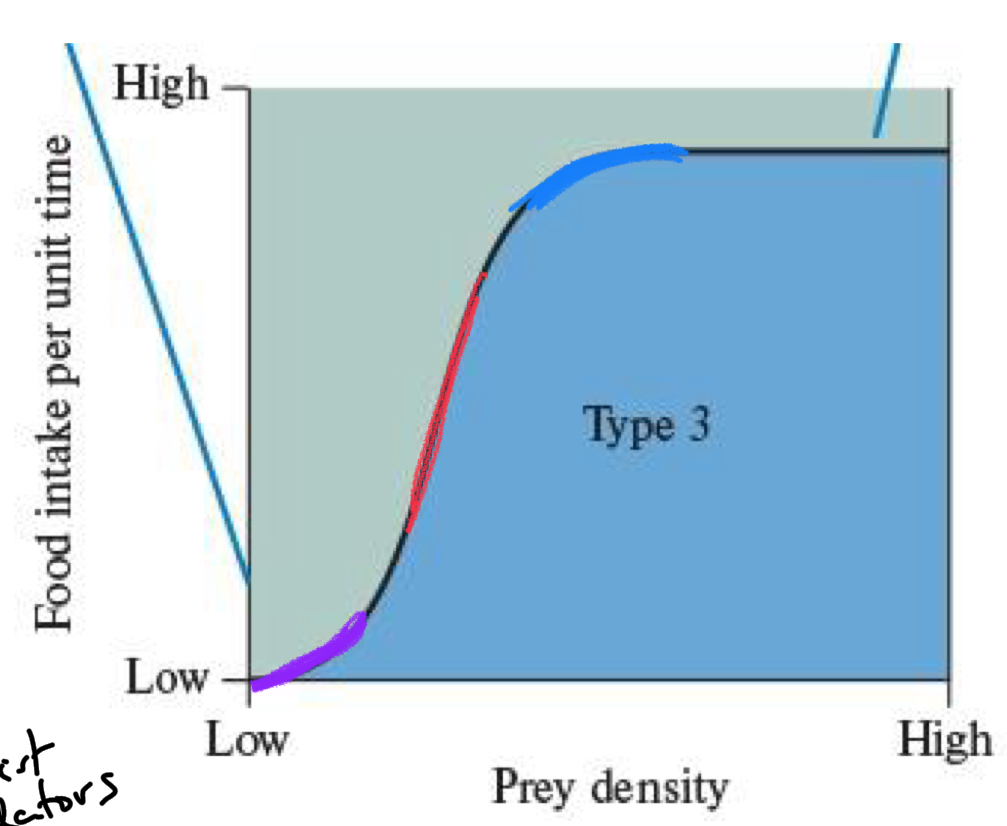
*****Why is the Type 3 Curve Sigmoidal/S shaped?
There is a LEARNING CURVE to capturing food
*****At low food density the Type 3 curve rate increases ______ (quickly/slowly)
Slowly
******WHY does feeding rate increase slowly at low food density for the Type 3 curve?
Finding food = Inefficient due to LACK OF EXPERIENCE, prey refuge or SWITCHING BEHAVIOUR
Limited by AGE, EXPOSURE + ENCOUNTER RATE
*****At Intermediate food density the Type 3 curve rate beings to ______ (speed up/ slow down) rapidly
SPEED UP
******WHY does feeding rate Start to INCREASE rapidly at Intermediate food density for the Type 3 curve?
Finding food = EFFICIENCY INCREASES
gaining experience + prey becomes easier to find
*******What is the limiting factor at HIGH prey density for the type 3 graph?
Handling + processing time only
enough food density + enough experience not that neither is limiting
*****What are 3 Example scenarios where animals may fall under type 3 Functional response curve?
Juvenile learning to hunt
Prey switching (generalist predators)
Searching for Rare prey
******Which of the Functional response curves is the Most rare and which is the most common?
Type 1 = RARE
Type 2 = COMMON
Summarize the 3 Types of Functional response curves in terms of SHAPE, MAIN LIMITING FACTORS, Why the SHAPE + Examples
Type | Shape of Curve | Explanation (Feeding Rate vs. Prey Density) | Main Limiting Factor(s) | Example Predators |
|---|---|---|---|---|
Type I | Straight line (linear, then sharp plateau) | Feeding rate increases linearly with prey density until predator is full/satiated. No handling limitation assumed. | Predator satiation | Filter feeders (e.g. whales, sponges) |
Type II | Curved upward, then levels off (hyperbolic) | Feeding rate rises quickly at first, then slows as predator spends more time handling prey. Eventually reaches max feeding rate. | Handling time | Most predators (insects, birds, mammals) |
Type III | S-shaped (sigmoidal) | Slow increase at low prey density (learning or prey hiding), then rapid rise (predators focus on abundant prey), then plateau (saturation). | Handling time + learning/prey switching | Generalist predators (birds, mammals, fish) |
****What is Optimal Foraging Theory + What does it attempt to Explain + predict (3 W’s)
Optimal foraging theory = how organisms feed as an optimizing process (max/min some factor eg. time, or E or predation risk)
Explains: WHEN, WHERE and WHAT an animal will eat
An approach to UNDERSTANDING BEHAVIOUR
****What is MARGINAL VALUE THEORUM? What is it a function of?
How long an animal should forage in a food patch before moving to a new location
An organism should spend time that MAX their E gain per unit time
Function of Total E gained vs. Total time spent foraging
***Is the amount of time spent in the patch the only time needed to be considered when looking at Marginal value theorem? What other TIME needs to be considered?
Time TRAVELLING TO PATCH
need to take into account amount of E used to find the patch
*****What happens if you leave the patch too early?
Use so much E to travel to patch but don’t stay long enough to get the MAX E from patch
*******At what point on the Graph is MAX E/TIME INVESTED
Steepest Slope
TANGENTIAL to Line
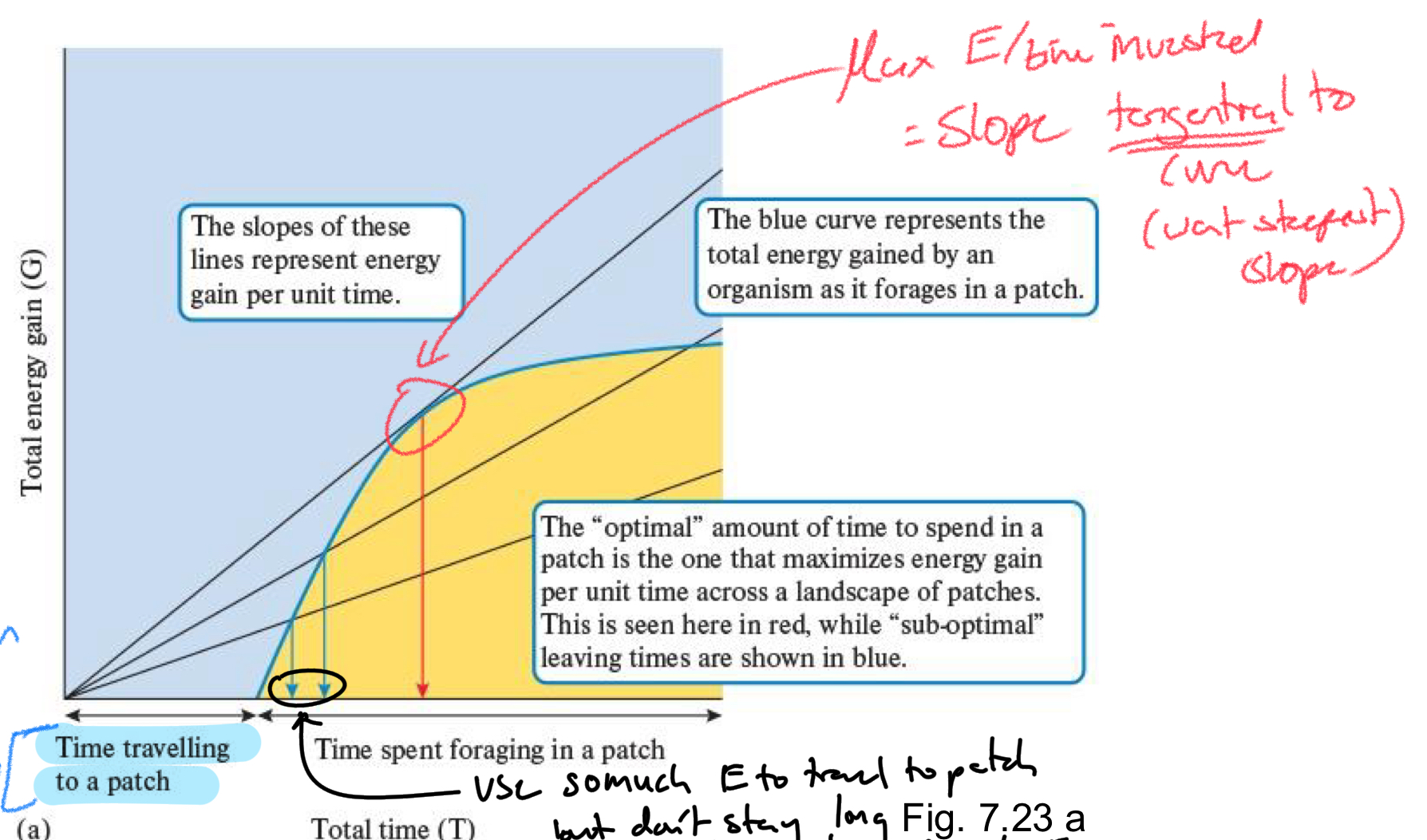
*****How does TRAVEL TIME to the patch Affect time spent foraging in a patch? Shorter travel time vs. Longer
Shorter = Leave SOONER
Longer = STAY longer
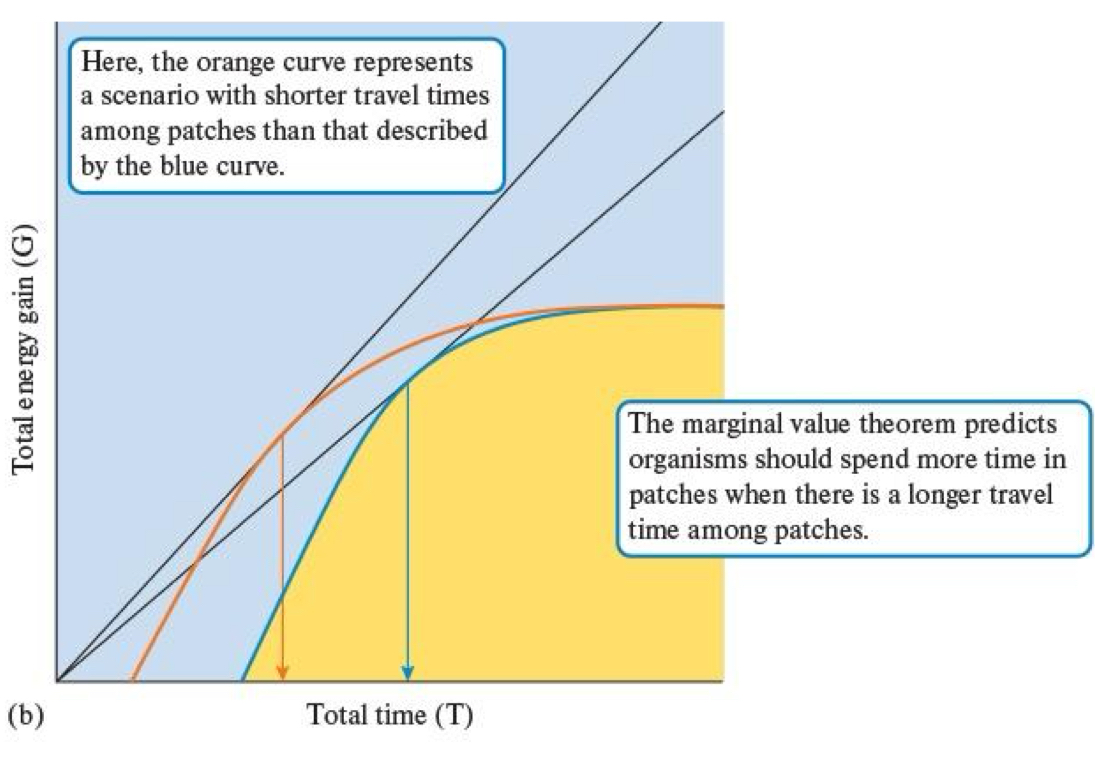
*****Optimal foraging: What is used to predict WHAT to eat?
Net Energy Gain from a Prey species
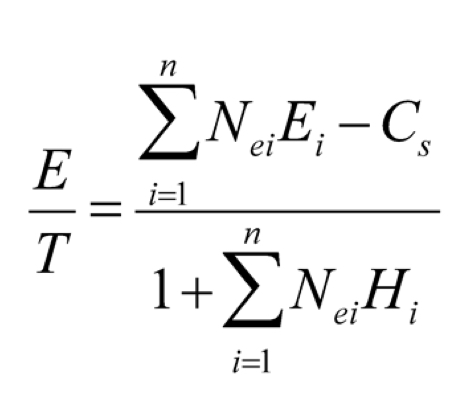
What do each of the components of the Net E intake formula represent?
E = Net E gain
T = Time
E1 = E gain from prey 1
Ne1 = Number of prey 1 encountered per unit time
Cs = E expended (Cost) searching for prey
H1 = Handling time of prey 1
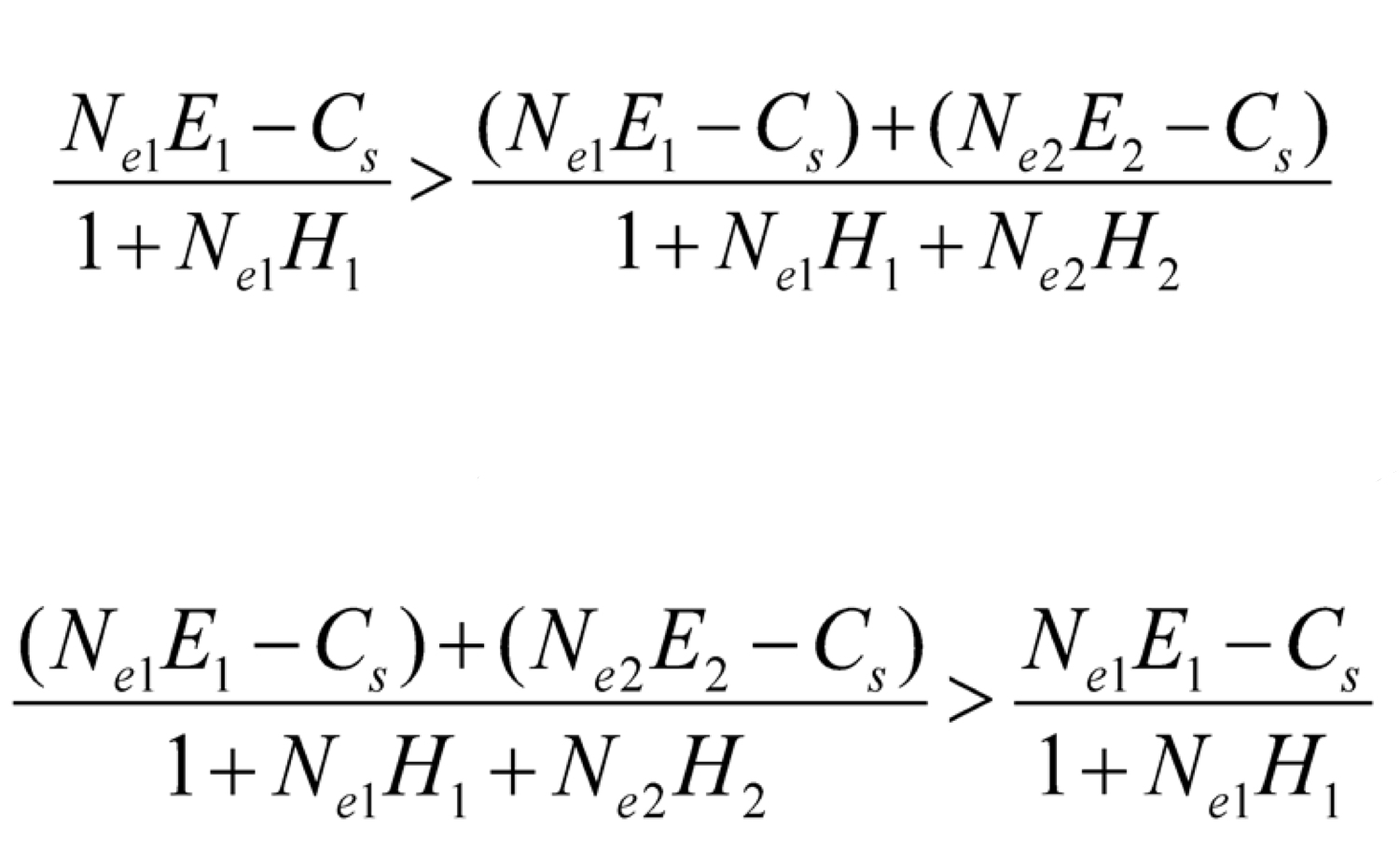
What does the top and bottom equation each mean about WHAT an animal should eat?
Top = Eating 1 prey is better than both
Bottom = Eating both prey = better than 1
Does Empirical research support optimal foraging theory?
YES (experiment with bluegill sunfish)
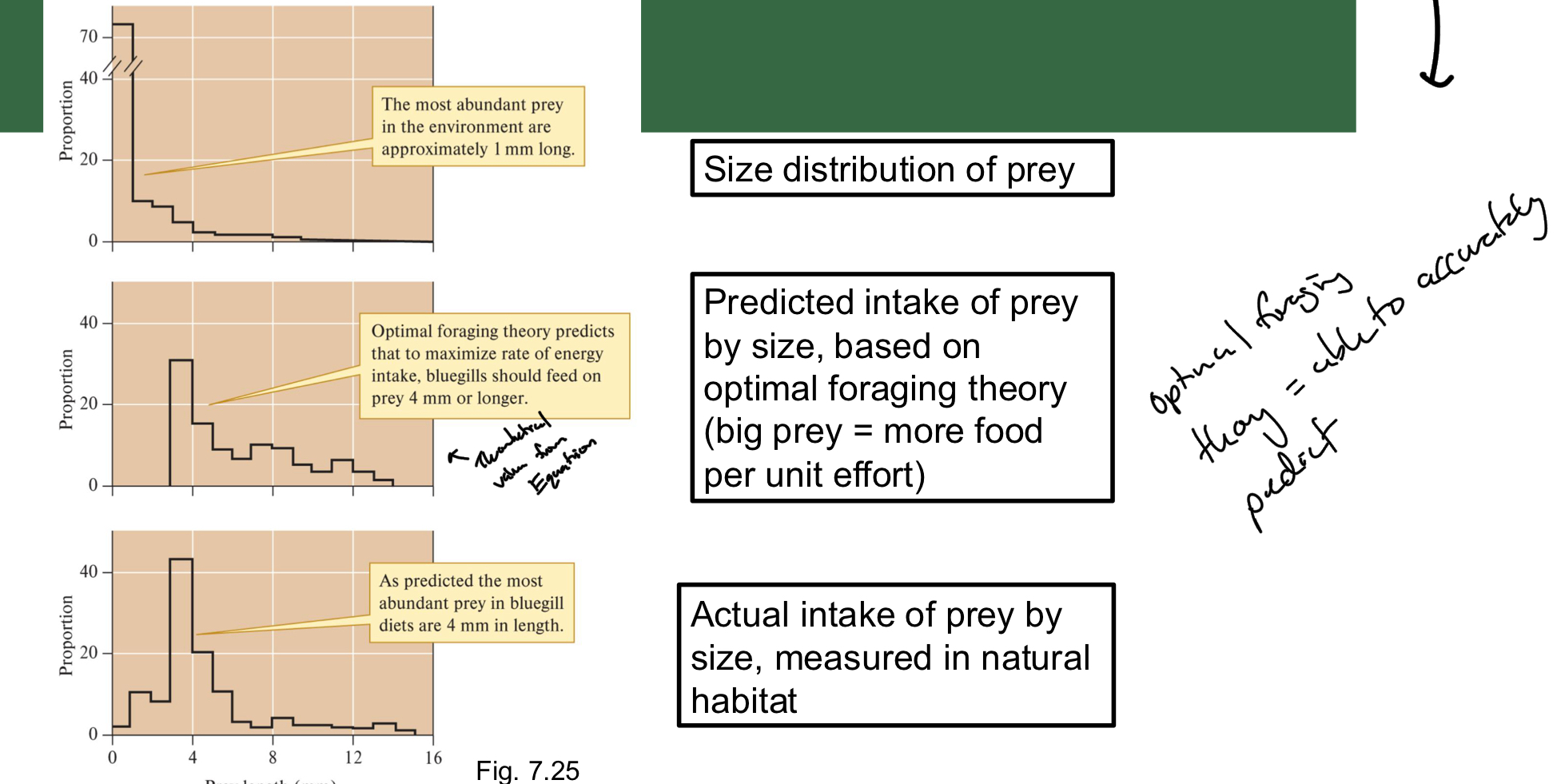
****What are the 2 ways plants optimally forage?
Long + deep ROOTS = MANY BRANCHES
Access soil with more nutrients
TALL shoots to reach light
What is Positive gravitropism?
Growth of plants roots in the direction of gravitational pull
this type of growth allow roots to take up water + nutrients + anchor into ground
Plants also face limited E. What trade off do they make?
Investing in Shoots Or Roots
****What are the 3 limiting factors of plants?
Nutrients in soil (N + P)
Water
Sunlight
How do plants adjust E allocation for trade off?
Depending on which resource is MORE LIMITING
******How do plants allocate in Nutrient poor soil?
Invest in more ROOTS
******How do plants allocate in low-light but nutrient rich conditions?
Incest more in shoots + Leaves